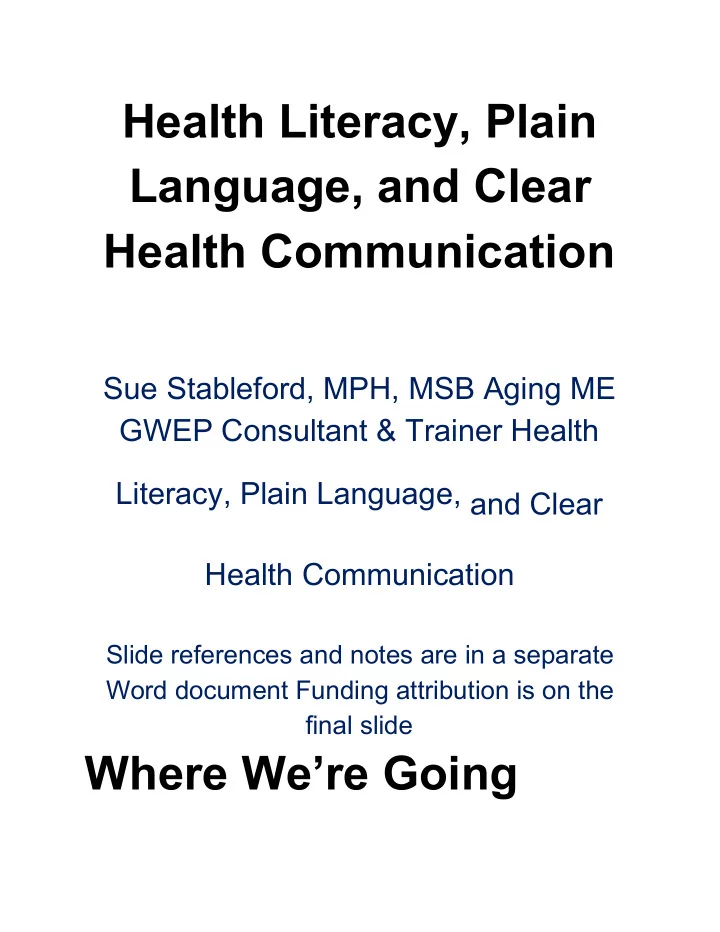

Health Literacy, Plain Language, and Clear Health Communication Sue Stableford, MPH, MSB Aging ME GWEP Consultant & Trainer Health Literacy, Plain Language, and Clear Health Communication Slide references and notes are in a separate Word document Funding attribution is on the final slide Where We’re Going
• Literacy and health literacy skills of American adults • Limited skills → communication challenge • Addressing the challenge with evidence- based practices – Plain Language – Plain Numbers – Teachback • National support for improvement 2 What is Health Literacy?
Perspective 1 Adult abilities to • Read • Write • Compute • Understand/Evaluate • Communicate • Use health information 3 2003 National Assessment of Adult Literacy [NAAL]
Prose Literacy Skills of American Adults 30 million 14% Below Basic 63 95 28 million million million 29% Basic 4 44% Intermediate 13% Pro- ficient More NAAL Results Quantitative Literacy Skills of American Adults 47 71
71 28 million million million million 22% 33% 33% 13% Below Basic Intermediate Pro- Basic ficient 5 NAAL health literacy results
Only 12% of adults have Proficient skills Sample Proficient task: Calculate an employee’s share of health insurance costs for a year, using a table that shows how the employee’s monthly cost varies depending on income and family size. 6 Most vulnerable
population groups Adults who are: • Older (esp. ages 65+) • Hispanic/Latino • Immigrants • Poor • Managing a chronic physical or mental health condition 7 2012 PIAAC similar to
2003 NAAL Results International survey: Scores in 5 levels (500 points) – In U.S., representative sample of 5000+ adults ages 16-65 – Overall, U.S. did poorly compared to other countries Higher levels = better scores • Literacy : 48% at levels 3,4,5 • Numeracy : 36% at levels 3,4,5
8 What do care systems and public health demand? Adults expected to manage: – Insurance and bills – Acute and chronic conditions – Preventive care – Treatment regimens – Health habits – Behavioral health – Care coordination – Quality surveys – And?? 9
How do many (most?) adults respond? 10 ... Health literacy
challenges everyone Limited • knowledge • skills • time • resilience Often, poor • health • vision or hearing • mobility • support system 11
Re-Defining Health Literacy Health Literacy Challenge Complex Health Systems Poor communications Consumer Complex Health knowledge, Systems Poor skills, communications self-efficacy Strong Emotions
Adapted from IOM conceptual framework in “ Health Literacy: A Prescription to End Confusion ”, 2003 12 The Communication “Gap” Consumer Skills vs System Demands Average literacy skills about
grade 8/9 Most health information at reading level 10 + Verbal teaching too fast in a “foreign language” 13 Impact: Serious for patients and systems Increased Consumer Risk • Low understanding of health
information • ↓ Knowledge and uneven adherence in managing chronic conditions → poor outcomes • ↓ Knowledge and likelihood of getting preventive care • ↑ Hospitalizations, costs, and deaths Increased System Risk • Suboptimal patient experience lower CAHPS scores
• Suboptimal outcomes • Increased costs and potential for malpractice claims 14 What works to address the problem? 3 evidence-based solutions Plain language Plain ✓ ✓ numbers ✓ Teachback
15 Plain language: More than words Using plain language means paying attention to: • Content Limited and focused • Organization/structure Key messages up front, small information chunks
• Writing Clear, using familiar terms and proven techniques • Design Visually supports key messages: ‘skim and scan’ • Culture Sensitivity and inclusion 16 Formal Definition of Plain Language 3 professional plain language groups agree on this definition: “A communication is in plain language if its wording,
structure, and design are so clear that the intended readers can easily find what they need, understand what they find, and use that information.” 17 Plain Numbers (Public Materials) “Use plain numbers” means: • Use whole numbers as much as possible, not decimals, fractions, or percentages
• Don’t expect consumers to do math - Do it for them • Provide context or ‘gist’ so consumers understand what the numbers mean for them • Write numbers as digits, not words (write 8, not eight) • Be aware of unfamiliar measurement units such as mmHg, and decide if just numbers meet needs • Keep charts, graphs, and tables
simple • Use consistent denominators and icons to explain risk 18 Teachback Assures understanding of verbal teaching • Educator teaches • Person tells or shows back in own words • Educator re-teaches as needed
An invitation, not “grilling” a learner 19 A Larger View: Policies and Programs Driving Change 1. Patient experience, patient engagement 2. Patient safety 3. Legal and fiscal considerations 4. Federal efforts 5. Affordable Care Act payment reforms 6.
Academic/professional practice standards 7. Hospital accreditation standards 20 Do “solutions” work? Evidence says yes...but • Understanding ↑ with better material design • Understanding ↑ with professional support • Reports from health systems mostly positive
21 Summing Up • We are all challenged by our complex and demanding care systems, especially when sick. • Only 12% have proficient health literacy skills. • We can help by using proven techniques: plain language, plain numbers, and teachback • Effective communication builds
patient trust and loyalty, meets regulatory requirements, and helps build healthy organizational culture • National efforts & trends support this work 22 How will you support evidence-based communication practice? Jot down or share one idea you can try in the next week
23 Funding Attribution This project is supported by the Health Resources and Services Administration (HRSA) of the U.S. Department of Health and Human Services (HHS) under grant number U1QHP33080-01-00, Geriatrics Workforce Enhancement Program, Year One-total award amount $749,999.00.
This information or content and conclusions are those of the author and should not be construed as the official position or policy of, nor should any endorsements be inferred by, HRSA, HHS or the U.S. Government. 24
Recommend
More recommend